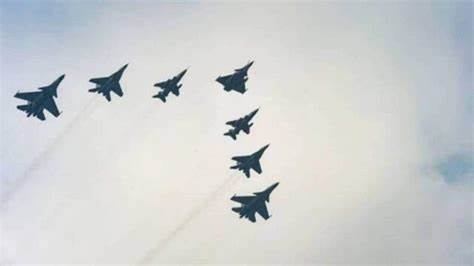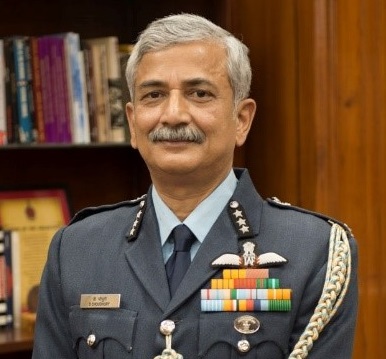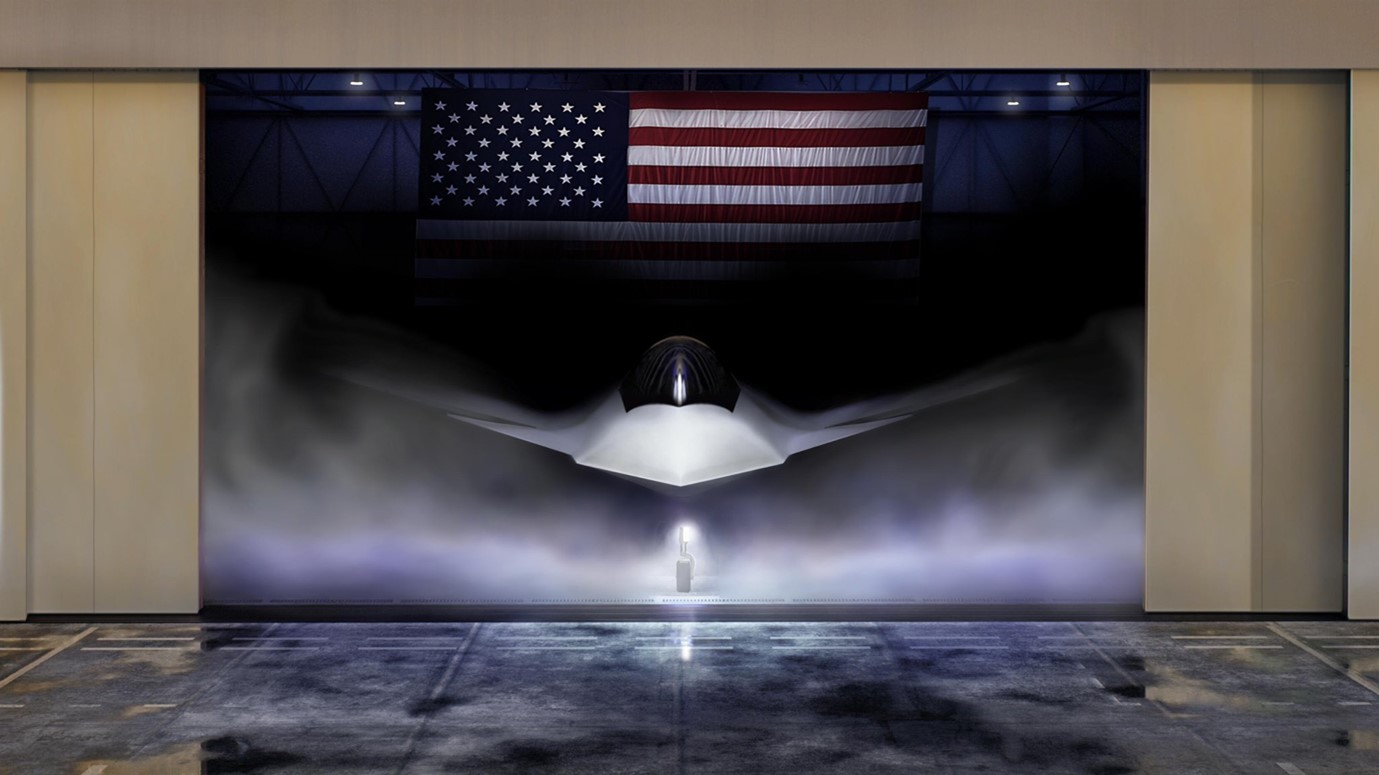
The Rising Wave of Air Power -Exercise Tarang Shakti

The largest-ever International Air Exercise that mainland Asia has seen in over six decades is underway as the Indian Air Force hosts friendly foreign Air Forces from thirty nations, ten as active participants, and the rest as observers. Exercise Tarang (Wave) Shakti completed its extremely successful first phase from August 6 to August 16 in the azure, blue skies over Sulur airbase situated in Tamil Nadu in the south, where France, Spain, Germany and the UK flew together with the IAF. The intervening break in the exercise has been factored to enable the second set of countries taking part, which include the USA, Australia, Japan, Singapore, Bangladesh, UAE and Greece, along with the large number of observer nations, to position and prepare for the second phase from August 29 to September 14, in Jodhpur airbase in Rajasthan. The large participation of nations despite the wars and conflicts underway in the world, underscores the international acknowledgement of the current and future salience of air power in national security.
Interestingly, the last time an air exercise of this scale was held in India was over six decades ago after the 1962 war with China, when the national leadership eschewed from committing IAF’s offensive air power in the debacle. It remains an unforgivable strategic mistake paid for in blood and continues to haunt us even today. Consequent to Prime Minister Nehru’s appeal to the US for assistance in bolstering India’s air defence, Air Forces from the USA, UK, and Australia came together for Exercise Shiksha way back in November 1963, in a world divided by the Cold War. Though the exercise was kept politically low key, it was a stark reminder of the disastrous consequences of not committing the combat proven air power of a nation in its defence. It also highlighted the vital necessity of a strong Air Force in India’s continental security, an enduring lesson that is increasingly relevant in today’s tenuous regional dynamics. However, unlike the past when the leading Air Forces of the time had brought their assets and personnel to train, exercise, and augment the nation’s air defence capability, this time the narrative is different. The number of Air Forces bringing in their latest air power assets to exercise with the IAF is a recognition and acceptance of India’s growing power trajectory and of its military capability.
This has not happened overnight, as the experience gained by the IAF’s participation in 91 bilateral and multilateral exercises over two decades, with almost all the leading Air Forces in the world, has paid enormous dividends. The Service earned a formidable reputation way back in 2004 in Exercise Cope India with the US, where the professional skills and innovative tactical agility of our aircrew flying legacy platforms, surprised the most powerful Air Force in the world. Since then, from Alaska in the US, France, the UK, and Greece in Europe, to Russia, Japan, Australia, the Middle East, and Southeast Asia, the IAF has notched up many friends in places. These engagements over the years have not only created unique ‘air bridges of friendship’ to strengthen our foreign policy and diplomatic initiatives, but they have also created opportunities for the exchange of contemporary and future relevant air power employment concepts and operational solutions, through the sharing of best practices. The international exposure has gone a long way to ensure the IAF’s contemporary operational capabilities remains honed, and that its doctrine and strategy remain agile and future relevant.
India’s geography and the complex political and security dynamics of the sub-continent present a unique threat paradigm, where the nation is faced with two nuclear-armed adversaries with strong Air Forces. The criticality of the asymmetric air power advantage which the vertical dimension provides in a nation’s conventional deterrence capability, that was amply evident in the Doklam and Galwan border standoffs against China, serves as a much needed refresher in India’s future continental security outlook. Cognisant of this, the PLA Air Force has stepped up its infrastructure and capacity development in Tibet, to neutralize India’s current operational air power advantage in the high altitudes. The PLAAF which last saw combat in the Korean War in the fifties, had very little exposure to how other Air Forces train and fight, and has sought to increase its participation in internationally. It participated first in Exercise Peace Mission with Russia under the aegis of the Shanghai Cooperation Organisation in 2007 and has since expanded its role in foreign military exchanges by attending international air shows and competitions since 2013. It has engaged with Pakistan, Turkey, Malaysia, and Thailand to widen its professional exposure, and conducts regular bi-laterals with Pakistan and Thailand. The tenth iteration of the bilateral Exercise Shaheen with Pakistan in 2023, and the very recently concluded fifth bilateral Exercise Falcon Strike with Thailand, have served to enhance the PLAAF’s operational ability.
Today there is a wide-spread recognition of the future relevance which the aerial dimension and the multi-domain air power capabilities bring to the table of comprehensive national power, not just as a military instrument, but also as a political and diplomatic one. The large participation in Tarang Shakti thus underscores the acceptance of India’s growing power in a world where China’s rapid military growth, great power ambition, and coercive foreign policy actions, have created serious concerns worldwide. Multi-lateral air exercises allow nations the choice of participating in varied operational training scenarios, ranging from large-scale complex combat employment missions, to combat support roles, or simply as observers. They also provide a multitude of cooperative options in the soft power spectrum like humanitarian assistance, disaster relief, mass evacuation, medical and logistic support, etc. Prior to the actual exercise, mission planning teams from different Air Forces rub shoulders to create realistic set-ups catering to the various platform types, as well as formulate mutually acceptable rules of engagement that balance mission objectives and mission safety. Blue and Red teams simulating friendly and opposition forces, carry out missions in near realistic conditions with and against different platform types and combat systems, weapon capabilities, and employment concepts, under the close and watchful eye of the White Force, who act as umpires to oversee the conduct and ensure key lessons and outcomes emerge.
Tarang Shakti opens the possibility of a much-needed air power employment in the maritime domain, to create a game-altering collective deterrence strategy in the regional security matrix among the nations affected by China’s military coercion. Considering the number of regional and extra-regional Air Forces, and the IAF’s engagement and relations with most of them, leveraging air power to bolster the net security of the region is a strategic opportunity to India’s advantage. It can play a significant out-of-the-box strategic role regionally by exploiting its AF to AF connects towards building a deterrent cooperative air power capability, by enhancing and exploiting air power interoperability and inter-usability with these nations. From conducting training and exercises, capacity building, export opportunities for our aeronautical and defence industrial base, to potential joint tasks and missions in the future, the exercise provides many options for enhancing India’s regional engagement. The demonstrated excellent performance of the Tejas fighter, which more than held its own among some of the best current fighters in the realistic operational scenarios, has validated of the potential of the nation’s aviation industry.
As the first phase of the exercise drew to a close in Sulur, the never-before four-aircraft formation flypast flown by the Air Chiefs of France, Germany, Spain, and led by the IAF Chief, stood testimony to India’s rising power stature. The second phase will commence shortly with a different and larger set of players and platforms, to engage in a more intense and complex set of mission profiles over the two-week duration. From a strategic perspective, this major exercise provides a framework for nations vested in enhancing the regional stability and security. Unlike the continental threat which is India-exclusive, the maritime security of the Indian Ocean region and the Indo-Pacific construct include a large number of nations with common interests toward countervailing the Chinese domination of the Asian waters. Inclusion of the significant land-based air power capabilities of the regional and other friendly Air Forces to collectively leverage the vertical dimension, will infuse a much-needed multi-domain multi-nation approach to strengthen India’s Security and Growth for all in the Region (SAGAR) strategy. As participating Air Forces fly together in the inaugural biennial Exercise Tarang Shakti, the most invaluable outcome will be the building and strengthening of mutual trust, respect, and friendship, which furthers India’s standing as a major power committed to the stability and security of the region.
1.Air Marshal Bharat Kumar, Unknown and Unsung, Indian Air Force in Sino-Indian War of 1962, KW Publications, New Delhi, 2013, p 353
2.Dr Marcel Haas, The ‘Peace Mission 2007’ Exercises: The Shanghai Cooperation Organisation Advances, Defence Academy of the United Kingdom, https://www.clingendael.org/sites/default/files/pdfs/20070900_cscp_paper_haas.pdf
3. Cristina L. Garafola and Timothy R. Heath, The Chinese Air Force’s First Steps toward Becoming an Expeditionary Air Force, RAND Research Report, Nov 2017, https://www.rand.org/pubs/research_reports/RR2056.html
4. https://www.globaltimes.cn/page/202308/1297196.shtml
5. https://thediplomat.com/2024/08/what-is-driving-thailand-and-chinas-falcon-strike-air-force-exercises/
6. Diptendu Choudhury, Security Vision 2047: A Hundred Years Since Independence, Nov 2022, VIF, https://www.vifindia.org/paper/2022/november/04/security-vision-2047-a-hundred-years-since-independence
7. Air Marshal (Dr) Diptendu Choudhury, Convergence of the Indo-Pacific with the Indian Ocean—Is a Maritime-Centric Approach Enough? An Indian Perspective, Journal of Indo-Pacific Affairs, May 08, 2024
,https://www.airuniversity.af.edu/JIPA/Display/Article/3766926/convergence-of-the-indo-pacific-with-the-indian-oceanis-a-maritime-centric-appr/
Disclaimer
The opinions expressed in this article are the author’s own and do not reflect the views of Chanakya Forum. All information provided in this article including timeliness, completeness, accuracy, suitability or validity of information referenced therein, is the sole responsibility of the author. www.chanakyaforum.com does not assume any responsibility for the same.
Chanakya Forum is now on . Click here to join our channel (@ChanakyaForum) and stay updated with the latest headlines and articles.
Important
We work round the clock to bring you the finest articles and updates from around the world. There is a team that works tirelessly to ensure that you have a seamless reading experience. But all this costs money. Please support us so that we keep doing what we do best. Happy Reading
Support Us















POST COMMENTS (0)